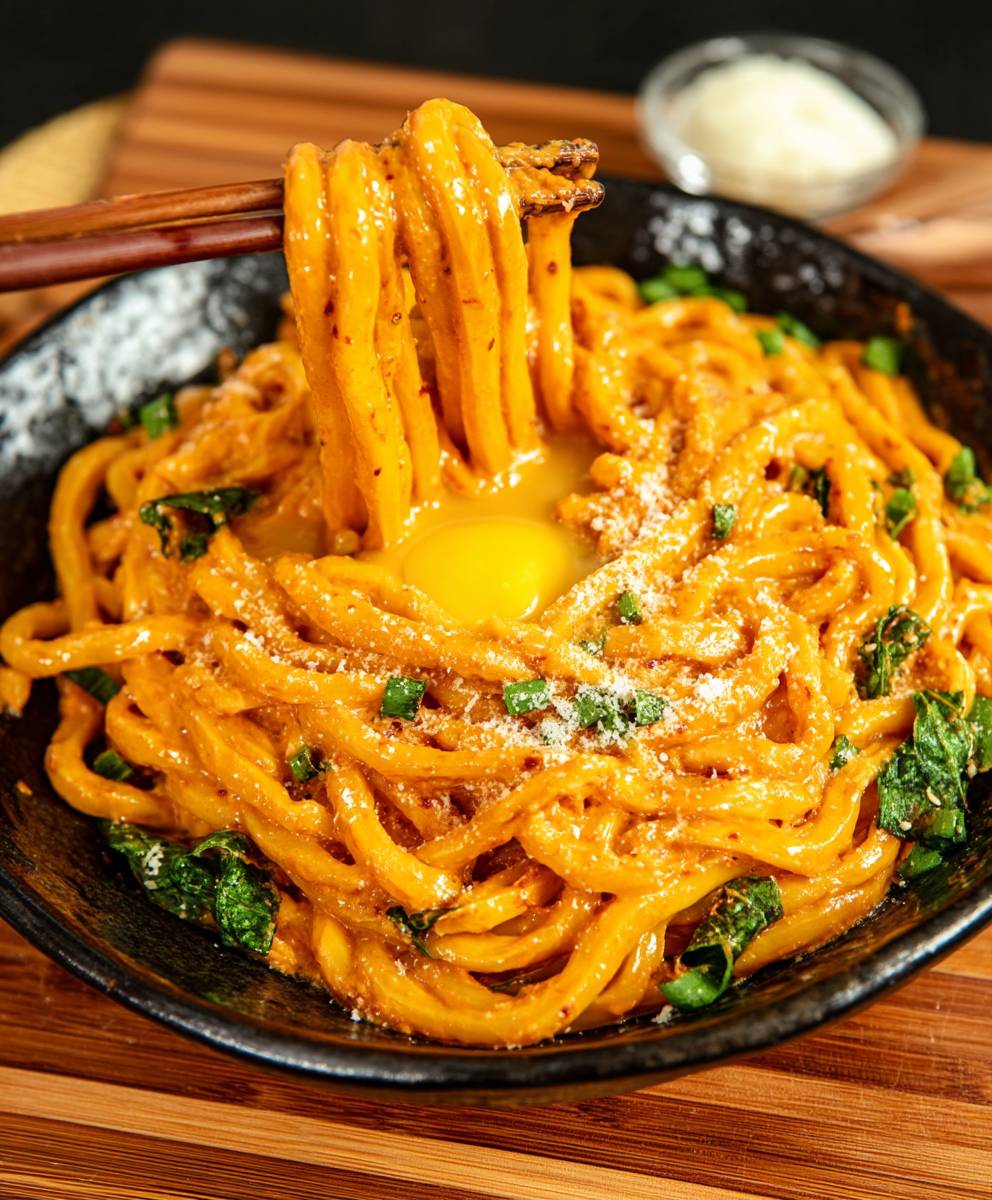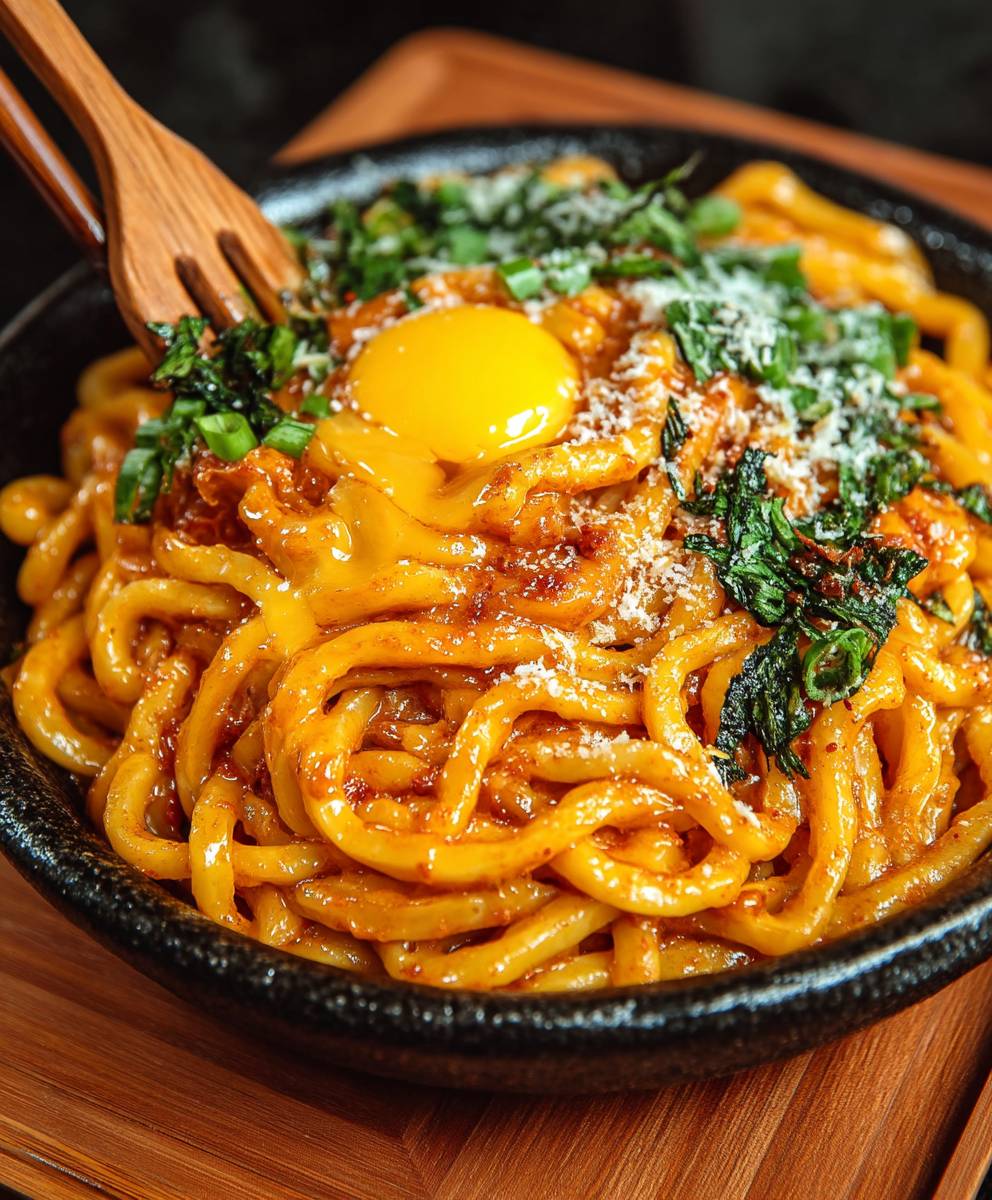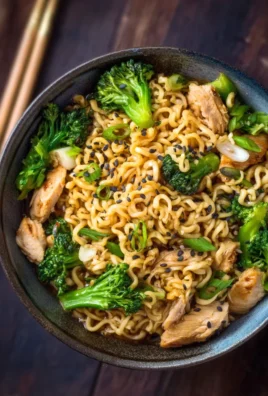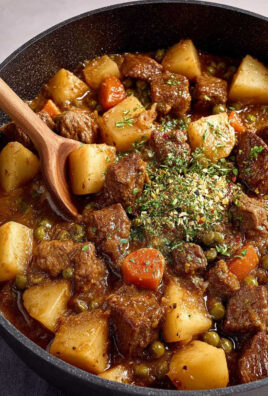Creamy Gochujang Udon Noodles: Prepare to embark on a flavor adventure that will tantalize your taste buds and leave you craving more! Imagine thick, chewy udon noodles, slicked in a vibrant, fiery, and utterly irresistible sauce. This isn’t just a meal; it’s an experience.
Gochujang, the star of this dish, is a fermented Korean chili paste that has been a staple in Korean cuisine for centuries. Its complex flavor profile – a delightful blend of spicy, savory, and slightly sweet – adds a depth and richness that elevates simple noodles to something truly extraordinary. While traditionally used in Korean stews and marinades, its versatility shines in this modern twist on a classic comfort food.
What makes Creamy Gochujang Udon Noodles so universally loved? It’s the perfect marriage of textures and tastes. The satisfying chewiness of the udon, the creamy smoothness of the sauce, and the exhilarating kick of the gochujang create a symphony in your mouth. Plus, it’s incredibly quick and easy to make, making it an ideal weeknight dinner option. Whether you’re a seasoned spice enthusiast or just looking to add some excitement to your meal routine, this recipe is guaranteed to become a new favorite.
Ingredients:
- 1 pound fresh udon noodles
- 2 tablespoons olive oil
- 1 pound boneless, skinless chicken thighs, cut into bite-sized pieces (or substitute with tofu for a vegetarian option)
- 1 medium yellow onion, thinly sliced
- 2 cloves garlic, minced
- 1 inch ginger, grated
- 1 red bell pepper, thinly sliced
- 1 green bell pepper, thinly sliced
- 4 ounces cremini mushrooms, sliced
- 2 tablespoons gochujang (Korean chili paste)
- 2 tablespoons soy sauce
- 1 tablespoon honey (or maple syrup for vegan)
- 1 tablespoon sesame oil
- 1/2 cup heavy cream (or coconut cream for vegan)
- 1/4 cup chicken broth (or vegetable broth)
- 2 green onions, thinly sliced, for garnish
- Sesame seeds, for garnish
- Optional: 1 teaspoon red pepper flakes, for extra heat
Preparing the Chicken and Vegetables:
- First, let’s get our chicken ready. In a medium bowl, toss the bite-sized chicken pieces with a pinch of salt and pepper. This will help season them evenly as they cook.
- Now, heat the olive oil in a large skillet or wok over medium-high heat. Once the oil is shimmering, add the chicken and cook until it’s browned and cooked through. This usually takes about 5-7 minutes, depending on the size of your chicken pieces. Make sure to stir occasionally to prevent sticking and ensure even cooking.
- Once the chicken is cooked, remove it from the skillet and set it aside. Don’t worry about cleaning the skillet just yet – we’ll use those flavorful bits left behind to build our sauce!
- Next, add the sliced onion to the same skillet and cook until softened and translucent, about 5 minutes. Stir occasionally to prevent burning.
- Add the minced garlic and grated ginger to the skillet with the onions. Cook for another minute, until fragrant. Be careful not to burn the garlic, as it can become bitter.
- Now, add the sliced red and green bell peppers and the sliced cremini mushrooms to the skillet. Cook until the vegetables are tender-crisp, about 5-7 minutes. Again, stir occasionally to ensure even cooking.
Making the Creamy Gochujang Sauce:
- This is where the magic happens! In a small bowl, whisk together the gochujang, soy sauce, honey (or maple syrup), and sesame oil. This mixture will form the base of our delicious sauce.
- Pour the gochujang mixture into the skillet with the vegetables. Stir well to combine, ensuring that all the vegetables are coated in the sauce.
- Add the heavy cream (or coconut cream) and chicken broth (or vegetable broth) to the skillet. Stir well to combine.
- Bring the sauce to a simmer and let it cook for a few minutes, until it thickens slightly. This will allow the flavors to meld together and create a rich, creamy sauce.
- Taste the sauce and adjust the seasoning as needed. If you want it spicier, add a pinch of red pepper flakes. If you want it sweeter, add a touch more honey (or maple syrup). If you want it saltier, add a dash more soy sauce.
Cooking the Udon Noodles:
- While the sauce is simmering, cook the udon noodles according to the package directions. Fresh udon noodles usually cook very quickly, often in just a few minutes.
- Drain the udon noodles well. You don’t want any excess water diluting your delicious sauce.
Assembling the Dish:
- Add the cooked chicken back to the skillet with the sauce and vegetables. Stir well to combine, ensuring that the chicken is coated in the sauce.
- Add the drained udon noodles to the skillet. Toss everything together until the noodles are evenly coated in the creamy gochujang sauce.
- Cook for another minute or two, until the noodles are heated through.
Serving and Garnishing:
- Serve the creamy gochujang udon noodles immediately.
- Garnish with thinly sliced green onions and sesame seeds.
- Optional: Add a sprinkle of red pepper flakes for extra heat.
- Enjoy your delicious and flavorful creamy gochujang udon noodles! This dish is perfect for a weeknight dinner or a special occasion. The combination of the spicy gochujang, the creamy sauce, and the chewy udon noodles is simply irresistible. I often make a double batch because it disappears so quickly! You can also customize this recipe to your liking by adding other vegetables, such as broccoli, carrots, or spinach. Feel free to experiment and make it your own!
Tips and Variations:
- Protein Options: Feel free to substitute the chicken with other proteins, such as shrimp, beef, or tofu. If using tofu, press it well to remove excess water before cooking.
- Vegetable Variations: Add other vegetables to the dish, such as broccoli florets, sliced carrots, or baby spinach.
- Spice Level: Adjust the amount of gochujang to your liking. If you’re sensitive to spice, start with a smaller amount and add more as needed.
- Vegan Option: To make this dish vegan, substitute the chicken with tofu, use maple syrup instead of honey, and use coconut cream instead of heavy cream.
- Make Ahead: You can prepare the sauce ahead of time and store it in the refrigerator for up to 3 days. When ready to serve, simply cook the noodles and add them to the sauce.
- Storage: Store leftover creamy gochujang udon noodles in an airtight container in the refrigerator for up to 3 days. Reheat in the microwave or on the stovetop.
Enjoy!
Conclusion:
This Creamy Gochujang Udon Noodles recipe is more than just a quick meal; it’s a flavor explosion waiting to happen, and trust me, you absolutely need to try it! The perfect balance of spicy, savory, and creamy creates a truly unforgettable dish that will have you craving it again and again. It’s incredibly easy to whip up, making it ideal for busy weeknights when you want something satisfying without spending hours in the kitchen. The chewy udon noodles perfectly soak up the rich, flavorful sauce, ensuring every bite is packed with deliciousness.
But what truly sets this recipe apart is its versatility. While it’s fantastic as is, there are so many ways to customize it to your liking. For a heartier meal, consider adding some grilled chicken, shrimp, or tofu. Sliced mushrooms, bell peppers, or spinach would also be wonderful additions, adding both texture and nutritional value. If you’re feeling adventurous, a sprinkle of toasted sesame seeds and a drizzle of sesame oil can elevate the nutty notes of the gochujang. And for those who like it extra spicy, a pinch of gochugaru (Korean chili flakes) will definitely kick things up a notch!
Serving Suggestions:
This Creamy Gochujang Udon Noodles is delicious served hot, straight from the pan. I personally love to garnish it with some chopped scallions for a fresh, vibrant touch. A side of kimchi or pickled radish provides a refreshing contrast to the richness of the sauce. You can also serve it as a side dish alongside Korean BBQ or other Asian-inspired meals. For a complete meal, consider adding a fried egg on top – the runny yolk adds another layer of richness and flavor that’s simply divine.
Variations:
* Vegetarian/Vegan: Easily make this recipe vegetarian by using vegetable broth and omitting any meat additions. For a vegan version, ensure your gochujang is vegan-friendly (some contain fish sauce) and use a plant-based cream alternative like cashew cream or coconut cream.
* Lower Carb: While traditional udon noodles are not low-carb, you can substitute them with shirataki noodles or zucchini noodles for a lighter option.
* Different Noodles: If you don’t have udon noodles on hand, you can use other types of noodles like spaghetti, fettuccine, or even ramen noodles. Just be sure to adjust the cooking time accordingly.
* Creamy Peanut Butter Gochujang Udon Noodles: Add a tablespoon or two of peanut butter to the sauce for a nutty and even creamier twist.
I’m so excited for you to try this recipe! It’s become a staple in my own kitchen, and I’m confident it will become one of your favorites too. The Creamy Gochujang Udon Noodles is a guaranteed crowd-pleaser, perfect for a quick lunch, a satisfying dinner, or even a potluck gathering.
So, what are you waiting for? Gather your ingredients, fire up your stove, and get ready to experience a flavor sensation. And most importantly, don’t forget to share your creations with me! I’d love to see your photos and hear about your variations. Tag me on social media and let me know what you think. Happy cooking! I can’t wait to see what you come up with!
Creamy Gochujang Udon Noodles: A Quick & Delicious Recipe
Creamy, spicy, and satisfying Gochujang Udon Noodles with chicken and vegetables, coated in a rich Korean chili paste sauce. A quick and easy weeknight meal!
Ingredients
Instructions
Recipe Notes
- Protein Options: Substitute chicken with shrimp, beef, or tofu. Press tofu well before cooking.
- Vegetable Variations: Add broccoli florets, sliced carrots, or baby spinach.
- Spice Level: Adjust the amount of gochujang to your liking.
- Vegan Option: Substitute chicken with tofu, use maple syrup instead of honey, and use coconut cream instead of heavy cream.
- Make Ahead: Prepare the sauce ahead of time and store in the refrigerator for up to 3 days.
- Storage: Store leftovers in an airtight container in the refrigerator for up to 3 days. Reheat in the microwave or on the stovetop.






Leave a Comment